It’s here already. The only thing you have to do is agree with it.
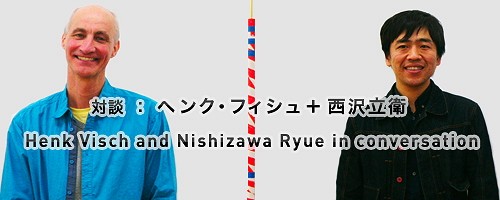
Horizontal/vertical/revolving: the artist and architect’s senses of space
HV: I went to Naoshima five years ago, alone, and I was amazed when I saw the ferry park, not knowing at the time that SANAA had designed it. What impressed me was that I felt it had reintroduced the horizontal to our world. We need the horizontal to move, not the vertical; we use the vertical to stay. In a city like Tokyo, it’s a vertical life, a vertical world. But with your work I feel that you’ve given the horizontal back to urban society.
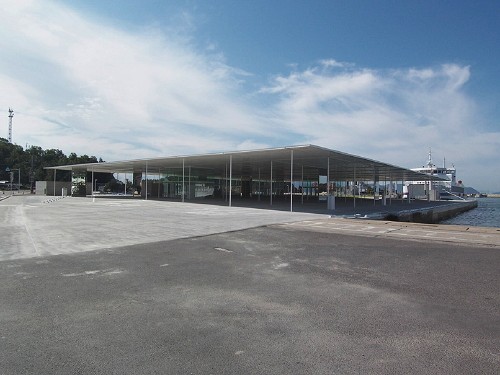 SANAA Marine Station Naoshima ©SANAA
SANAA Marine Station Naoshima ©SANAANR: I think that’s true. The buildings in the vicinity of the ferry park are at maximum two stories, and the majority just one story. The environment is very different to an urban setting: you look out at sea, sky and islands – that’s what inspired this approach. The appeal of the horizontal that you pointed out in your observations about directional space was the appeal we observed in the town and the sea, and we decided to create that architecturally.
On the other hand, the work [There (2006)] you did for the VIVO City shopping complex in Singapore, designed by Ito Toyo, addresses vertical space in an interesting way.
HV: That was challenging project for me, because I was given the highest floor. I thought, This is the top, how can there be more? There’s no next floor. And it’s mostly kids that go up there. I puzzled over how to ‘finish’ because anything I would do would be the highest point of the building. I struggled with this idea of…
NR: How to finish the building? (Laughs)
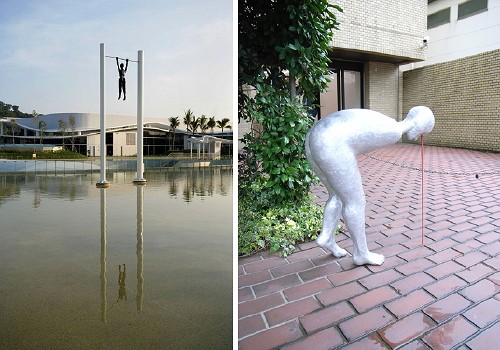 Left: Henk Visch There 2006
Left: Henk Visch There 2006Right: Henk Visch Think 2005 Installation view at Wako Works of Art
© Henk Visch Courtesy Wako Works of Art
HV: Precisely! And in the end I decided to make a revolving figure, that is, to create no fixed ending. So it would not become a point that says, ‘Here is the end.’ It would turn the space back upon itself. And it works. So I am very happy about it. It inspired me to write a little text about ‘here and there’.
Accepting what is
NR: Coming back to your show here in Tokyo, you’ve transformed even the exterior space. I’d remembered that gallery has a parking space out front, so I came today by car, but as I was pulling in I saw your sculpture, [Think (2005)] and once again was astonished by how it changed the function of the space completely.
HV: Because it mimics human behavior. I’m very interested in the public – partly because I don’t feel very public myself. I always try to sense somebody in the public, to project what that person sees and perceives; I try to look at my own work with the eyes of an anonymous person.
NR: To me Think is public, but also very private – I feel there are some very private stories behind it. All of your works, in fact, are very cute, very lovely, but at the same time, very scary. It’s rather amazing to see these two totally different qualities come together with no contradiction.
HV: No contradiction, I like that. We have this idea of a goal, which is a form of convergent perspective, but I think as an artist, in order to be able to accept and digest things, you also have to have a divergent perspective. Which is like Asian perspective isn’t it?
NR: It may be. The Japanese sensibility, at any rate, doesn’t really embrace a sense of so-called ‘perspective’; it is basically flat. There isn’t the kind of dramatic space that converges to one point. It’s more diffusely organized, more prosaic.
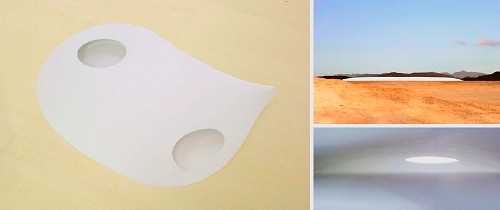 Nishizawa Ryue Teshima Museum (planned opening 2010) © Office of Ryue Nishizawa
Nishizawa Ryue Teshima Museum (planned opening 2010) © Office of Ryue NishizawaHV: While Western perspective converges to one point, which is probably Jesus. This morning I went to an exhibition of Korean ceramics where I read as perspective what was actually Korean letterforms. My Western eyes are predisposed to see perspective. But I’ve learned by being in Asia, and my exposure to your works, to disengage somewhat from this view.
NR: To me your works feel very European. The way the emotions come into play feels very mature.
HV: Mature, I don’t know, but I am very European. It’s one of those things that I have to accept. And though I don’t like to think or say so, I am also very Christian, even though I am not a Christian believer – I have no religion. But I realize that my figures are very Christian figures. My hope is to be more free from fixed ideas. But we are educated in a language, and words are loaded with cultural ideas. Take sin for example, or shame, or guilt – concepts I don’t even want to think about! I don’t use those words when I speak myself, but they are in me, like my bones. They are part of my heritage.
NR: When I was younger, I didn’t really care about where I belonged, but once I started travelling abroad, everybody kept referring to me as Japanese. At first it didn’t even ring true, but after hearing it again and again and again, I began to think, hey, maybe I am (laughs). Fortunately, I now have a better understanding of my origins and the context in which I grew up. I am also very aware of the way things Japanese – the seasons, the flora, the climate, and even the food – influence my work.
The world already exists
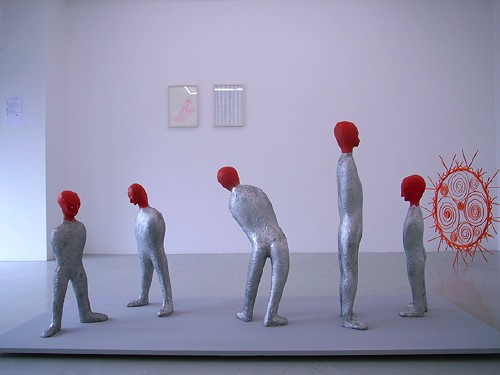 Installation view of Henk Visch’s exhibition I have seen real happiness nowhere, but it is doubtless here at Wako Works of Art
Installation view of Henk Visch’s exhibition I have seen real happiness nowhere, but it is doubtless here at Wako Works of ArtNR: Architects normally approach a project in light of the program requirements and the existing environment, or the site. The site is a given. The project comes to the site. We create something new based on an existing context. I sensed a similar attitude in your work about respecting the existing property, about relating to the existing context.
HV: Yes, that’s true of my public works. But in my studio works the existing context is generally immaterial. My site is not sand or stone, but rather ideas and traditions. And that’s something I adore about art: that you are not like a zombie or alien from outer space, but that you are part of a tradition. Although I work freely – I don’t consider myself a traditional artist – I am aware of tradition. There is such a long tradition in images. People have been visualizing their ideas ever since they started to think. So this is the site that I excavate.
I read somewhere – and this interests me greatly – that if you speak it is in fact thanks to language. So whatever I say means that I agree with language. The notion of agreeing, of accepting, is also very much something I am aware of – that I have to agree with what is. And that attitude is reflected in the lines from Voltaire’s science fiction short story ‘Micromégas’ that I chose as the title of this show: ‘I have seen happiness nowhere, but it is doubtless here’. It’s here already. The only thing I have to do is agree with it.
Henk Visch
Born 1950 in Eindhoven (NL), lives and works in Eindhoven. After boyhood dreams of becoming a conductor, actor, composer and architect, among other things, in 1980 he finally settled into his career as an artist. His great many commissioned sculptures appear in a wide variety of architectural settings including the Dutch Pavilion at the Shanghai Expo. International exhibitions include the 1988 Venice Biennale and Documenta IX (1992). In 2006 he exhibited works throughout the Moriyama House (Tokyo), a residence designed by architect Nishizawa Ryue.
http://www.henkvisch.nl/
Nishizawa Ryue
Born 1966 in Kanagawa. Established SANAA (Sejima And Nishizawa And Associates) with Sejima Kazuyo in 1995 and the Office of Ryue Nishizawa in 1997. Major works include the 21st Museum of Contemporary Art, Kanazawa, the New Museum (New York) and Towada Art Center. Professor at Yokohama National University. Winner with Sejima Kazuyo of the 2010 Pritzker Prize.
http://www.sanaa.co.jp/
http://www.ryuenishizawa.com/
Henk Visch: I have seen happiness nowhere, but it is doubtless here
2 April – 22 May
Wako Works of Art (Tokyo)
http://www.wako-art.jp/
Supported by the Embassy of the Kingdom of the Netherlands, Japan
Teshima Art Project (Teshima Museum of Art: designed by Nishizawa Ryue; Artwork by Naito Rei)
Setouchi International Art Festival 2010
19 July – 31 October
Teshima, Kagawa
http://setouchi-artfest.jp/
